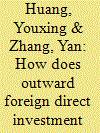| Srl | Item |
| 1 |
ID:
159043


|
|
|
|
|
| Summary/Abstract |
Using an original linked firm-level panel data from Chinese manufacturing firms over the period 2002–2007, this paper examines how outward foreign direct investment (OFDI) led productivity increase of parent firms (known as the own-firm effect) changes over firm heterogeneity. Conducting propensity score matching (PSM) techniques and differences-in-differences (DID) analysis, we find strong and robust evidence that the first OFDI promotes parent firm's productivity and this effect varies substantially with the firms' characteristics. In particular, firm's absorptive capacity is essential for the own-firm effect, and the absorptive capacity related with the product innovation is more important than that of the process innovation for the own-firm effect. Also, OFDI strategies for obtaining advanced technology and investing in developed countries significantly strengthen the own-firm effect, whereas, government supports have no significant impacts on the own-firm effect.
|
|
|
|
|
|
|
|
|
|
|
|
|
|
|
|
| 2 |
ID:
141178


|
|
|
|
|
| Summary/Abstract |
Using the Cobb–Douglas production function and vertical specialization share, the present paper measures the productivity spillover effects of offshore outsourcing in the Chinese manufacturing industry. We examine different production factors and the degree of openness by dividing the Chinese manufacturing industry into five major categories: capital-intensive business, technological-intensive business, labor-intensive business, open business and non-open business. The results show that offshore outsourcing is positively associated with productivity in the Chinese manufacturing industry as a whole, but less so in labor-intensive industries and more in capital-intensive industries. Moreover, the positive impact of outsourcing on productivity is slightly higher in open industries than in non-open industries. These results shed light on the differential spillover effects of offshore outsourcing on productivity. Our findings suggest that outsourcing structure is important to China's long-run competitive advantage. China's policy-makers should encourage further offshore capital-intensive and technology-intensive activities and focus more on outward-oriented offshore businesses.
|
|
|
|
|
|
|
|
|
|
|
|
|
|
|
|
| 3 |
ID:
126534


|
|
|
|
|
| Publication |
2013.
|
| Summary/Abstract |
Aims
The industrial sector dominates the China's total energy consumption, accounting for about 70% of energy use in 2010. Hence, this study aims to investigate the development path of China's industrial sector which will greatly affect future energy demand and dynamics of not only China, but the entire world.
Scope
This study analyzes energy use and the economic structure of the Chinese manufacturing sector. The retrospective (1995-2010) and prospective (2010-2020) decomposition analyses are conducted for manufacturing sectors in order to show how different factors (production growth, structural change, and energy intensity change) influenced industrial energy use trends in China over the last 15 years and how they will do so up to 2020.
Conclusions
The forward looking (prospective) decomposition analyses are conducted for three different scenarios. The scenario analysis indicates that if China wants to realize structural change in the manufacturing sector by shifting from energy-intensive and polluting industries to less energy-intensive industries, the value added average annual growth rates (AAGRs) to 2015 and 2020 should be more in line with those shown in scenario 3. The assumed value added AAGRs for scenario 3 are relatively realistic and are informed by possible growth that is foreseen for each subsector.
|
|
|
|
|
|
|
|
|
|
|
|
|
|
|
|